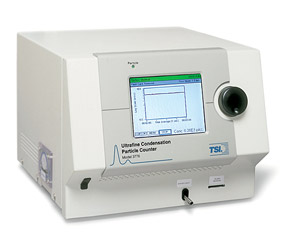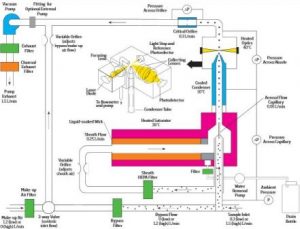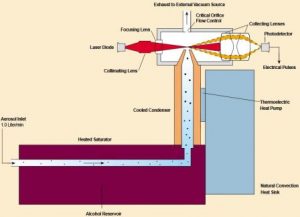Instrument Support Level 2
TSI Inc, 3750, 3776
ncas-cpc-3750-1, ncas-cpc-3750-2, ncas-cpc-3776-1, ncas-cpc-3776-2, ncas-cpc-3756-1, ncas-cpc-3756-2
aerosol-concentration
33750 - £20,000. 3776 - £33,000, 3756 - £33,000
24 cm × 25 cm × 38 cm. 11 kg
See page for details
£20
Calendar

Ultrafine Condensation Particle Counter
The 3776 Condensation Particle Counter (CPC) is designed primarily for researchers interested in airborne particles smaller than 20 nm. With sensitivity to particles down to 2.5 nm, this UCPC is ideally suited for atmospheric and climate research, particle formation and growth studies, combustion and engine exhaust research, and nanotechnology research. It is compatible with TSI Scanning Mobility Particle Sizer™ (SMPS™) spectrometers.
The 3756 Condensation Particle Counter (CPC) is the long-standing reference for counting ultrafine particles down to 2.5 nm. This 4th generation CPC is easier use for everyone with an intuitive direct-touch user interface, new software, and secure internal data storage for months of data. Improved performance, new features and diagnostics.
The 3750 Condensation Particle Counter (CPC) is a compact, rugged instrument that detects airborne particles down to 7 nanometers in diameter. Due to a high signal-to-noise ratio that limits false background counts to nearly zero, it detects these small particles with remarkable accuracy. The 3750 samples and counts submicrometer particles on a continuous basis, enlarging them to a size that can be detected easily. It offers an upper concentration limit of 10,000 particles per cubic centimeter and responds quickly to concentration changes, showing accurate readings in a matter of seconds. It operates quietly and does not introduce contaminants into the surrounding area. The unit can run without being attached to a laptop and is designed for long term ambient monitoring. The 3750 is only compatible with the new 3082 base SMPS units.
There are two identical 3776 units available
There are two identical 3750 units available
There are two identical 3756 units available
3776
In a laminar-flow, alcohol-based CPC, an aerosol sample is drawn continuously through a heated saturator in which alcohol is vaporized and difuses into the sample stream. Together, the aerosolsample and alcohol vapor pass into a cooled condenser where thealcohol vapor becomes supersaturated and ready to condense. Particles present in the sample stream serve as condensation nuclei. Once condensation begins, particles that are larger than a threshold diameter grow quickly into larger droplets and pass through an optical detector where they are counted easily. Using a unique sheath-air-flow design that confines the aerosol flow path near the centerline of the condenser, the Model 3776 detects particles as small as 2.5 nanometers in diameter. This design exposes particles to the region of the highest supersaturation and uniformity of alcohol vapor. As a result, even the smallest particles can be activated and grown to large droplets for easy optical detection. This unique design greatly enhances measurement response time, produces a sharply defined lower-size-detection limit (counting efficiency curve), and minimizes diffusion losses of ultrafine and nanoparticles. An internal pump draws the aerosol sample into the Model 3776. The inlet flow can be configured for either high-flow mode operation (1.5 L/min) to improve response time and minimize particle transport loss, or low-flow mode operation (0.3 L/min) to provide flexibility when used as part of an SMPS spectrometer. In high-flow mode, 1.2 L/min of the inlet flow is diverted as a bypass flow. In both high and low-flow modes, 0.3 L/min of the inlet flow passes through the saturator, condenser, and optics regions of the instrument. Just prior to the aerosol flow capillary, the 0.3 L/min sensor flow splits into a 0.25 L/min sheath flow and a 0.05 L/min aerosol flow. The sheath flow is cleaned by a HEPA filter and drawn through a heated, liquid-soaked, porous tube where it becomes saturated with alcohol vapor. The aerosol sample joins the filtered vapor-saturated sheath flow right before the inlet of the condenser. A short, heated section at this juncture allows vapor to diffuse into the aerosol before entering the cooled condenser. The volumetric flow rate of the 0.3 L/min sensor flow is controlled accurately using a critical orifice, which also allows the use of an external vacuum source without a change in flow control.

3750
During operation, alcohol condenses onto particles in the sample flow, creating aerosol droplets large enough to be detected efficiently using a light-scattering technique. Upon entering the CPC, the sample passes through a saturator block, where alcohol evaporates into the sample stream. The flow becomes saturated with alcohol vapor. The sample then passes into a vertical condenser tube cooled by a thermoelectric heat pump. Here, the alcohol vapor supersaturates and condenses onto virtually all particles larger than 10 nanometers, regardless of chemical composition. As droplets exit the condenser, they pass through a thin ribbon of laser light. Light scattered by these droplets is collected by optics and focused onto a photodetector. The photodetector converts the light signal to an electrical pulse, which is recorded as a particle count.

The instrument are serviced annually, either by the manufacturer or the AMOF IS. This includes checking the flow rate, optics alignment and replacing filters and tubing. The instrument is then compared with a reference instrument.
It should be noted that there is no absolute calibration standard for particle number concentration.
A basic service check will be performed on a unit before it is shipped to the user.
Consumables
- The 3750, and 3776 CPC use reagent grade n-butyl alcohol (butanol), which can be purchased from suppliers such as Sigma-Aldrich. It is important to note that a unit will be shipped dry (empty) and that it must be returned dry. It is not advisable to tip the unit when it is full.
- The user is responsible for the disposal of any waste butanol.
- The exhaust of the CPC can be passed through activated charcoal to remove the butanol vapour. This can be purchased from suppliers such as Sigma-Aldrich.
- Tubing to connect the CPC to a sampling system or environment will not be provided.
Costs
- Instrument Insurance
- This system must be insured by the user for 3750 – £20K, 3776 – £33k and covers loss, theft or damage to the instrument: damage is that over and above general wear and tear. The system has been designed to be rugged and autonomous. Even so, the end-user must respect the fact that the system is a precision optical instrument that must be treated with great care.
- The user is responsible for the instrument from the time it leaves the AMOF to the time it is returned and signed off as in an acceptable operating condition by the IS: this will be done as soon as is possible on its return.
- Public Liability Insurance
- The AMOF is not liable for any damage or injury arising from the deployment or operation of this instrument when unattended by the IS.
- Shipping Expenses
- The user is liable for all costs arising from the shipping of the instrument both to and from a deployment.
- IS T&S
- The user is responsible for coving the travel and subsistence expenses of the IS while attending the instrument.
Shipping
Please contact the IS for details nearer the time of shipping. If exact weights and dimensions are required, these can be arranged with the IS.
The instrument needs to be housed in a dry environment that does not exceed the environmental conditions as detailed in the specifications. The instrument should be situated on a level surface.
The unit should be sited in a well ventilated area. If not, then there needs to be suitable ventilation for the exhaust e.g. fume cupboard.
Eye safety
- The 3750, and 3776 UCPCs are class 1 laser-based instruments and are eye safe for all conditions of use, providing the covers are not removed.
Electric safety
- Under no circumstances should any attempt be made to open up the main body of the instrument. Only appropriately qualified persons should attempt to fault find these units.
Attended operation
- There is no requirement for the system to be attended during operation from a safety standpoint.
COSHH
- Users are responsible for generating their own COSHH risk assessments for handling, storing and use of butanol, the working fluid of the CPC.
- Butanol is potentially toxic; it is also flammable.
- The IS can provide examples of risk assessments and COSHH forms as a guide.
Ventilation
- The UCPC will vent butanol vapour from the exhaust of the instrument. This must not be vented to an enclosed space. It is advisable to vent to outdoors or a fume cupboard. The exhaust can be passed through activated charcoal if there is a risk the exhaust could contaminate other measurements.
3750
When unpacked the instrument has the following physical specification (excluding pump)
- Sample flowrate
- 1.0 L/min (0.035 cfm) ± 10%
- Vacuum source
- 450 mm (18 in. )Hg minimum
- Particle size range:
- minimum detectable particle 50% of 0.01 μm particles
- maximum detectable particle >3 μm
- Particle concentration range:
- 0.0001 to 10,000 particles/cm3 (3 to 2.8 × 108 particles/ft3) with <10% coincidence at 10,000 particles/cm3
- Background count:
- <0.0001 particle/cm3
- Working fluid
- Reagent-grade n-butyl alcohol
- Reservoir capacity
- 350ml (7 day supply at 22 C)
- Light source
- 50 mW, 780 nm laser diode
- Signal-to-noise ratio
- 20:1 minimum
- Digital output:
- (note: not compatible with TSI Models 370x or 71xx multiplexer or processors)
- square pulse:
- 5 V, 500 ± 100 ns
- 16 bit analog output:
- 0-10 volt full scale (0-11 volt under HOST control)
- Serial Communications I/O:
- Pinouts compatible with standard 9-pin IBM-AT style RS-232 cables and interfaces
- Power
- 100/120/220/240 VAC @ 50/60 Hz, 25W maximum
- Size (LWH):
- 19 by 22 by 19 cm (8.5 by 7.5 by 7.5 in)
- Weight
- 5.5 kg (12 lbs)
- Ambient temperature range:
- 10 to 35°C
- Ambient humidity range:
- 0 to 90% RH
3776
- Minimum particle size
- 50% detection at 3 nm
- 90% detection at 5 nm
- Flowrate
- Aerosol
- 30 ± 3 cm3/min
- Condenser
- 300 ± 30 cm3/min
- Inlet, high-flow
- 1500 ± 150 cm3/min
- Inlet, low-flow
- 300 ± 30 cm3/min
- Aerosol
- Working fluid
- n-butyl alcohol
- saturator temperature
- 37°C ±0.3°C
- condenser temperature
- 10°C ±0.3°C
- optics temperature
- 39°C ±2.0°C
- Concentration
- 0 to 9.99 × 104 particles/cm3
- Accuracy
- ±10% up to 9.99 × 104/cm3
- Environmental conditions
- Indoor use altitude up to 2000 m (6500 ft)
- Ambient temperature range n-butyl alcohol
- 10–37°C
- Ambient humidity
- 0–90% RH noncondensing
- False background counts
- <0.01 particle/cm3
- Response time
- <1 second for 95% response to concentration step changeswhen sampling in high-flow mode; <5 seconds when sampling in low-flow mode
- Dimensions L × H × W (nominal)
- 24 cm × 25 cm × 38 cm (9.5 in. × 10 in. × 15 in.)
- Weight
- 11 kg (25 lb)
- Power
- 100/120 V at 50/60 Hz, 180 W, 1.2 A (maximum)
- 230/240 V at 50/60 Hz, 180 W, 0.6 A (maximum)
These instrument measures the number concentration per cubic centimetre of particles in the size range:
- 3750: 7nm to ~3,000nm. The lower size, 7nm, is defined as the D50, whereby 50% of the particles are counted and detected.
- 3776: 2.5nm to ~3,000nm. The lower size, 2.5nm, is defined as the D50, whereby 50% of the particles are counted and detected.
Field Data
- The instrument produces a range of out files and all are text format.
- The user can download (but not delete) this data from the instrument but it should be noted that this data will not have been quality controlled.

Archive Data
- Data is provided in NetCDF files following the AMOF data standard
- Files contain no more than 24hr of data.
- Instrument name is
- ncas-cpc-3750-1
- ncas-cpc-3750-2
- ncas-cpc-3776-1
- ncas-cpc-3776-2
- ncas-cpc-3776-3
- ncas-cpc-3776-4
- The data product(s) associated with this instrument:
- Example data file
- How to use example data
- ncas-cpc-3750-1_ral_29001225_aerosol-concentration_v0.1.nc
- ncas-cpc-3750-2_ral_29001225_aerosol-concentration_v0.1.nc
- ncas-cpc-3776-1_ral_29001225_aerosol-concentration_v0.1.nc
- ncas-cpc-3776-2_ral_29001225_aerosol-concentration_v0.1.nc
- ncas-cpc-3776-3_ral_29001225_aerosol-concentration_v0.1.nc
- ncas-cpc-3776-4_ral_29001225_aerosol-concentration_v0.1.nc
